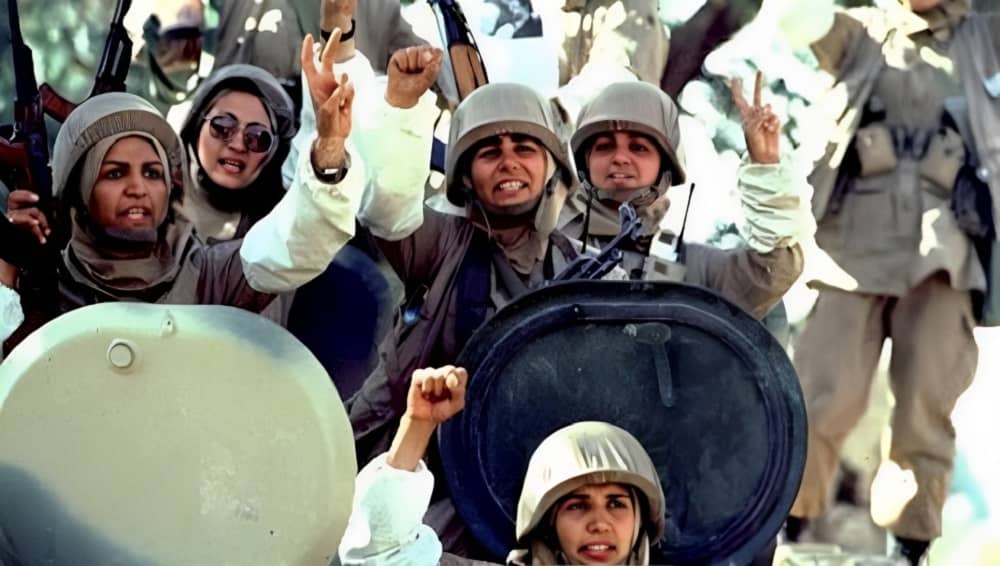Facebook
Twitter
LinkedIn
Pinterest
Reddit
Email
Print
 Victorious female fighters of the National Liberation Army chant “Today Mehran, tomorrow Tehran” after liberating the strategic border city of Mehran on June 18, 1988
Victorious female fighters of the National Liberation Army chant “Today Mehran, tomorrow Tehran” after liberating the strategic border city of Mehran on June 18, 1988
Three-minute read
When Iran’s ruling establishment accepted a cease-fire on June 24, 2025—after twelve days of devastating missile exchanges, nationwide blackouts, and a collapsing economy—it rushed to declare “victory” in official statements. But beneath the bravado was unmistakable retreat. Much like in 1988, when the regime abruptly agreed to end its eight-year war with Iraq, this truce was not a product of strength—but of fear. Not fear of a foreign enemy, but of an uprising at home.
The wars did not descend upon Iran out of the blue; they were provoked, enabled, and prolonged by the regime’s own aggressive designs—its strategy of exporting crisis abroad to suppress rebellion within.
In the 1980s, the regime’s refusal to end the war with Iraq after reclaiming lost territory prolonged the bloodshed for years. Rather than prioritize national security, it gambled on a messianic fantasy of “liberating Jerusalem through Karbala”—a war it could never win but used to tighten control and silence dissent. The ultimate price? Over one million dead, a broken economy, and a military left vulnerable to a lightning offensive by the National Liberation Army (NLA), which in the summer of 1988 miraculously seized the city of Mehran. The NLA’s pace, morale, and daring crushed regime defenses and sent shockwaves through the establishment. When the resistance declared “Today Mehran, tomorrow Tehran,” the illusion of invincibility shattered—and the founder of the regime drank what he called a “poisoned chalice.”
MEK’s Impact on the #Iran-Iraq Warhttps://t.co/DQC5tILQhe
— NCRI-FAC (@iran_policy) September 30, 2023
Thirty-seven years later, the pattern has repeated—with a new face, but the same fear.
The regime’s role in laying the groundwork for the 2025 conflict is unmistakable. Its long-standing support and coordination with militant groups in the region—culminating in the October 7, 2023 attacks—was a reckless attempt to reshape the regional balance of power. It hoped to project force, distract from its domestic paralysis, and rally its waning base. But instead, it triggered a direct war—this time on Iranian soil.
Once again, the regime overestimated its strength and underestimated the consequences. It found itself facing not just foreign airstrikes, but internal collapse. Blackouts spread across the country in the peak of summer heat. Entire neighborhoods in Ahvaz, Shiraz, and even the capital went dark. Water supplies dwindled. The economy, already battered by years of sanctions and mismanagement, flatlined.
And most dangerously for the ruling elite—something began to stir in the streets.
Iran: The Nationwide Uprising and the Role of MEK Resistance Unitshttps://t.co/3E0d9NG8pQ
— NCRI-FAC (@iran_policy) April 28, 2023
Unlike 1988, today’s internal threat is more decentralized, more agile, and more embedded in society. Resistance Units affiliated with the People’s Mojahedin Organization of Iran (PMOI/MEK), which the regime has long tried to dismiss or suppress, have become a nucleus of organized defiance. From Tehran’s metro stations to small towns like Izeh and Quchan, they document regime weakness, disrupt its control, and catalyze public anger. This is not scattered protest—it is structured resistance. They are not waiting for a foreign military campaign; they are building one from within.
It is this domestic front that terrifies Khamenei more than foreign firepower. He remembers how his predecessor collapsed under the pressure of an advancing resistance army. Today, the same fear hangs over the ruling elite—magnified by a society that is younger, angrier, and more connected than ever. Every act of defiance, every video leaked from a protest, every slogan spray-painted on a wall is a crack in the regime’s armor.
The war’s end did not bring calm. The regime, stripped of strategic options, has returned to its default setting: threats and theatrics. Its state media lashes out—promising revenge, threatening to “set the region ablaze,” even calling for the execution of international officials. But no amount of saber-rattling can obscure the fact that the regime is running out of fuel—politically, economically, and literally.
Thirty-Six Years After NLA’s Grand Operation, #Iran’s Regime Shivers While Hailing Its Survivalhttps://t.co/5wj000ZU5S
— NCRI-FAC (@iran_policy) July 28, 2024
While it cannot rebuild bombed-out military sites quickly, it also cannot turn on the lights in its hospitals. Its “strategic depth” in the region is being lost to retreats and realignments. And at home, its social base is eroding. The regime’s loudest threats are directed not at foreign countries—but at the people of Iran themselves.
In the end, the core parallel between 1988 and 2025 is this: both cease-fires were not tactical recalibrations, but acts of survival. They were not concessions to external pressure, but desperate attempts to delay internal implosion. Both times, the clerical regime claimed it had crushed the enemy—but both times, it backed down not because it chose peace, but because it feared defeat.
Khamenei, like his predecessor, has discovered that strategic depth means little when you lack social depth.
The truce may hold for now. But beneath the surface, another front is growing. This time, it doesn’t wear uniforms or fly planes. It writes on the walls. It strikes at night. And it says, louder than any missile: “Tomorrow, Tehran.”